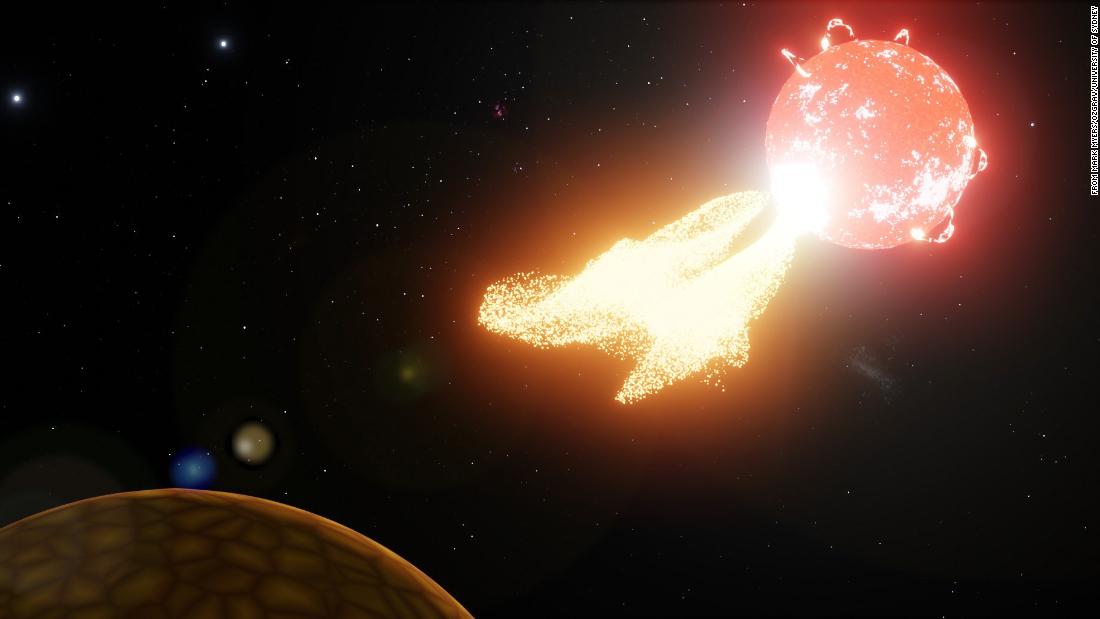
While Proxima b is 20 times closer to its star than Earth is to the sun, it receives a similar amount of energy -- heat and light -- that Earth does from the sun because Proxima Centauri is a cooler and smaller star.
This puts the planet in the so-called "Goldilocks zone" of not too hot and not too cold for some form of life to exist. That means it's thought to have a possible surface temperature range where liquid water could exist on the planet's surface. Scientists equate liquid water with life on Earth, and it has informed their search for life beyond it as well.
However, new research has dampened hopes that any suggestion of life could exist on its surface, with the planet likely experiencing inhospitable space weather.
A team of Australian researchers have shown for the first time a definitive link between optical flares and radio bursts on a star that is not the sun. The finding, according to the study published Wednesday in The Astrophysical Journal, was an important step to using radio signals from distant stars to help understand the dramatic effects of space weather on solar systems beyond our own.
"Our own Sun regularly emits hot clouds of ionised particles during what we call 'coronal mass ejections.' But given the Sun is much hotter than Proxima Centauri and other red-dwarf stars, our 'habitable zone' is far from the Sun's surface, meaning the Earth is a relatively long way from these events," said lead author Andrew Zic, who undertook the research while at the University of Sydney, in a news statement.
Coronal mass ejections are hugely energetic expulsions of ionized plasma and radiation leaving the stellar atmosphere.
"The Earth has a very powerful planetary magnetic field that shields us from these intense blasts of solar plasma. But given Proxima Centauri is a cool, small red-dwarf star, it means this habitable zone is very close to the star; much closer in than Mercury is to our Sun," said Zic, who is now a postdoctoral researcher at Macquarie University.
"What our research shows is that this makes the planets very vulnerable to dangerous ionising radiation that could effectively sterilize the planets."
The findings strongly suggest planets around this type of star are likely to be showered with stellar flares and plasma ejections and may suffer strong atmospheric erosion, leaving them exposed to very intense X-rays and ultraviolet radiation.
It was possible, Zic said, that radio bursts might happen for different reasons than on the sun, where they are usually associated with coronal mass ejections. But "the probability that the observed solar flare and received radio signal from our neighbor were not connected is much less than one chance in 128,000," he said.
"This is probably bad news on the space weather front. It seems likely that the galaxy's most common stars - red dwarfs - won't be great places to find life as we know it," Zic added.
However, Zic said it was in theory possible that exoplanets - planets outside our solar system -- could have magnetic fields like Earth's.
There have been no observations of magnetic fields around exoplanets yet, the statement said, and finding these could prove tricky.
"Even if there were magnetic fields, given the stellar proximity of habitable zone planets around M-dwarf stars, this might not be enough to protect them," Zic said.
Proxima b was first found by astronomers in 2016 and its existence was confirmed again this year. It's one of about 4,000 exoplanets that have been spotted since the 1990s.
The observations of Proxima Centauri were taken with the CSIRO's Australian Square Kilometre Array Pathfinder (ASKAP) telescope in Western Australia, the Zadko Telescope at the University of Western Australia as well as other instruments.
https://www.cnn.com/2020/12/09/world/proxima-centauri-exoplanet-habitability-scn/index.html
2020-12-09 14:48:00Z
CAIiEEM0ichBgDisttXstpe1xgMqGQgEKhAIACoHCAowocv1CjCSptoCMPrTpgU
Bagikan Berita Ini















0 Response to "Observations of our closest neighboring star dampen hopes of a potentially habitable planet - CNN"
Post a Comment